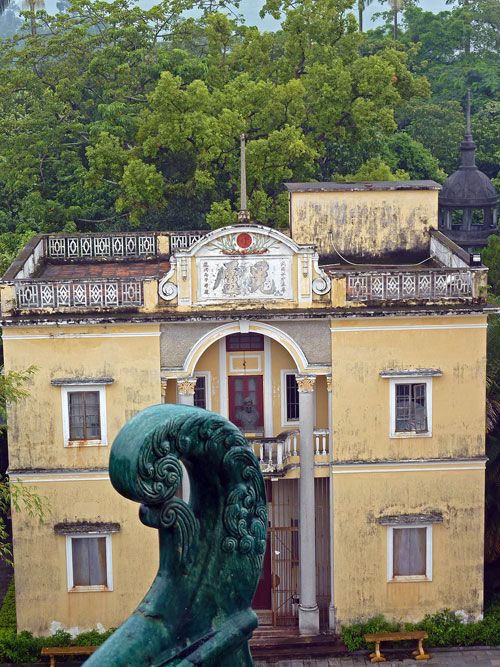Li Yuan 立园 / Li Gardens: The Posh Diaolou
Kaiping 开平 Guangdong Province 广东省
Li Yuan or Li Gardens: Heading on past Sanmenli from Kaiping, the next important group of Diaolou buildings is in the Li Yuan, or Li Gardens, a further 10 kms down the road. These are the posh Diaolou. Click here to see what is a Diaolou
The huge buildings are set in lovely gardens which mix European and Southern Chinese Lingnan style garden designs. (http://www.chinaplanner.com/gardens/privategardens/pri_lian.htm).
The Diaolou in the Li Gardens are the most European in the Kaiping region. Many resemble French Villas with only the eave roofs giving away their Chinese essence. They exude wealth and power and wouldn’t be too out of place on the Champs-Élysées (maybe the cheaper end). The interiors of the Li Garden’s Diaolou are luxuriously furnished and gorgeously decorated.
The contrast between the amazing buildings and the surrounding rural scenery is incredible! From any of the roof tops you can look out over a countryside that has hardly changed since the Li Gardens were built. There are peasants working in the rice paddies and buffalo wading in the ponds. And then there are these magnificent buildings…
Construction on the Li Gardens began in 1926 and lasted nearly 10 years. The owner, Mr. Xie Wei Li, an overseas Chinese, had made his fortune in America. Apart from the buildings, the gardens themselves are very pretty and extremely atmospheric; especially the bridges and stone pathways. It’s easy to spend a few hours here.
Like most Diaolou, the Li Garden also has a tragic story. One area of Diaolou was built to remember Mr. Xie Wei Li’s favorite second wife, Tan Yu-Ying, who died soon after their marriage when Mr. Wei was back in America.
There are many such sad stories on the plaques outside the buildings, telling of family tragedies such as the early death of a beloved spouse, the endless wait – often in vain – for the emigrated husband to return, wealth lost to the Japanese invaders, children dying of starvation and so on. The stories testify to the – almost insurmountable – distance between the émigrés new host countries and Kaiping, as well as to the violent times in which they lived.
During the Japanese occupation many of the buildings were ransacked and the inhabitants forced to flee. However, painstaking and tasteful restoration has brought back much of the previous glory to the buildings of the Li Gardens.
 Getting to the Li Yuan / 立园 / Li Gardens
Getting to the Li Yuan / 立园 / Li Gardens
If you’re not hiring a driver, many local buses from Kaiping’s Yici 义祠 bus station pass by the Li Gardens. Unlike some of the more distant Diaolou groups, the Li Gardens do receive their share of Chinese tourists (as does Zili village); there is even a coach park, a silly children’s playground with naff miniature Dutch windmills and other copies of famous buildings and some souvenir stalls, but not so many as to spoil the place.
 To and from Kaiping
To and from Kaiping
Getting to Kaiping is no sweat; there are buses from all Guangzhou bus stations, though it can be difficult to get an exact timetable. As we were staying on Shamian Dao / Shamian Island, we used the nearby Fangcun bus station. To get there from Shamian Island, take subway line One from Huangsha and get off at Kengkou station and cross the bridge. There are hourly buses, 60 Yuan, 2½ hours. They leave you at Kaiping’s new Yici 义祠 bus station, which is a few kilometers away from the central Kaiping Binguan and the waterfront. Regular buses from Kaiping also go to Shenzhen, Zhuhai, Zhaoqing (the one we took when we were leaving) and Hongkong.











Wow, this is still China? China is so vast and amazing. I love the Tibetan areas.